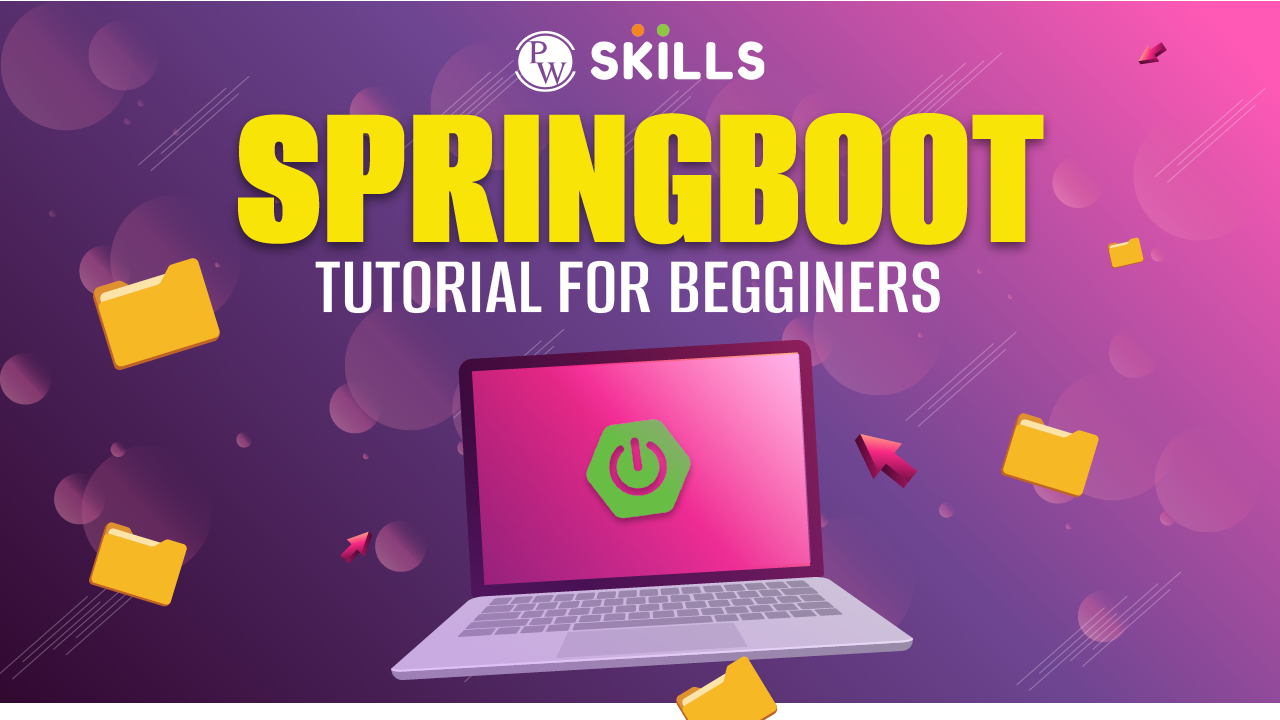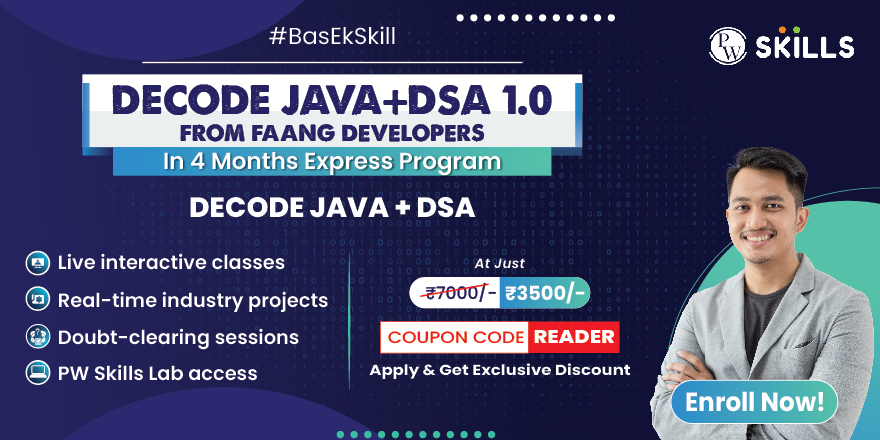Spring Boot is a popular framework for building standalone, production-ready JAVA applications. Following this Spring Boot tutorial will teach you everything about Spring Boot!
Spring Boot Tutorial: In the dynamic landscape of Java development, Spring Boot has emerged as a powerful framework, streamlining the process of building robust and scalable applications. In this Spring Boot tutorial, we’ll talk about Spring Boot, its advantages, limitations, goals, how to create, interview questions, and much more!
What is Spring Boot?
Spring Boot is the Spring Framework, making it easier to create production-ready apps with less setup. It has conventions and defaults for faster development, letting developers concentrate on business logic, not infrastructure.
While Spring Boot is built on the foundation of the Spring Framework, it introduces a convention-over-configuration paradigm, significantly reducing the need for boilerplate code. This relationship ensures that developers can seamlessly leverage the capabilities of the Spring ecosystem.
Advantages of Spring Boot
Here are a few advantages of spring boot:
1. Rapid Development and Prototyping
Spring Boot’s opinionated defaults and conventions enable developers to quickly prototype and develop applications, reducing the time spent on configuration. This speed is particularly advantageous in agile development environments.
2. Simplified Configuration
Gone are the days of XML-based configurations. Spring Boot embraces sensible defaults and annotations, minimising the need for extensive configuration files. This simplicity enhances readability and maintainability.
3. Embedded Server Support
With embedded servers like Tomcat and Jetty, Spring Boot removes the requirement for external server setups. This simplifies deployment, ensuring the app runs independently without external dependencies.
4. Microservices Architecture Facilitation
Spring Boot is well-suited for microservices development, allowing developers to create independently deployable services. Its modular and lightweight nature aligns with the principles of microservices architecture.
Also read: Best Online JAVA Platform To Learn Java Programming Course
Limitations of Spring Boot
While Spring Boot may have a lot of advantages, there are also some limitations that you must know about. Here are some of them:
1. Complexity for Large-scale Applications
Spring Boot excels in swift development, but handling complexity in large-scale apps poses challenges due to its convention-over-configuration approach. Balancing simplicity and customization is crucial for developers.
2. Learning Curve for Beginners
For beginners, the plethora of annotations and the Spring ecosystem might seem overwhelming. However, with a step-by-step approach, developers can gradually grasp the concepts and harness the power of Spring Boot.
3. Limited Customization Options in Some Cases
In certain scenarios, developers might require fine-grained control over configurations, which Spring Boot may limit due to its opinionated nature. While this simplifies development, it might not suit all use cases.
Recommended Technical Course
- Full Stack Web Development Course
- Generative AI Course
- DSA C++ Course
- Java+DSA 1.0 Course
- Data Analytics Course
- Data Science with ML 1.0 Course
Goals of Spring Boot
Here are some goals that Spring Boot aims to achieve:
1. Enhancing Productivity
Spring Boot aims to boost developer productivity by providing a set of defaults and conventions, reducing the time spent on boilerplate code. This enhancement allows developers to focus on writing business logic.
2. Simplifying Configuration
The goal of Spring Boot is to minimise the configuration overhead traditionally associated with the Spring Framework. This is achieved through sensible defaults, auto-configuration, and annotations.
3. Promoting Convention over Configuration
By emphasising convention over configuration, Spring Boot reduces the need for explicit configuration files, making the development process more intuitive and less error-prone.
4. Facilitating Production-Ready Applications
Spring Boot’s key aim is simplifying the development of production-ready applications. It accomplishes this by incorporating built-in functionalities for monitoring, health checks, and addressing various production-related considerations.
Prerequisites of Spring Boot
Here are some prerequisites that you must be aware of before you start Spring Boot:
Knowledge of Java Programming Language
Mastering Java is crucial before delving into Spring Boot, necessitating comprehension of syntax, object-oriented programming, and fundamental concepts such as classes and methods.
Basics of the Spring Framework
While not mandatory, a foundational understanding of the Spring Framework is beneficial. Concepts like dependency injection, inversion of control, and aspect-oriented programming are integral to both Spring and Spring Boot.
Familiarity with Build Tools (Maven or Gradle)
Spring Boot projects are typically managed using build tools like Maven or Gradle. Familiarity with these tools is important for setting up and building Spring Boot applications.
Also read: 13 Java Coding Games Will Help You Master Java in 2024
Spring Boot Features
Here are some of the best features of Spring Boot:
| Feature | Description |
| Auto-Configuration | Automatically configures the Spring Boot application based on the project’s classpath, reducing the need for manual configuration and improving development efficiency. |
| Starter Dependencies | Pre-packaged sets of dependencies that simplify the inclusion of common features. Starters streamline the build process and enhance project maintainability. |
| Spring Boot CLI | The Spring Boot Command Line Interface allows developers to interact with and develop Spring Boot applications directly from the command line, aiding in rapid prototyping. |
| Spring Boot Actuator | Provides production-ready features for monitoring and managing applications, including endpoints for health checks, metrics, and application information. |
| Spring Boot Security | Built-in support for securing applications using Spring Security, simplifying the configuration of authentication, authorization, and other security-related features. |
Spring Boot Tutorial in Java
Follow these steps as a Spring Boot Tutorial in Java:
1. Set Up a Spring Boot Project
Starting a Spring Boot project is simple with Spring Initializr, a web tool. It sets up a basic project with chosen dependencies, project type (Maven or Gradle), and language (Java or Kotlin).
2. Create a Simple Spring Boot Application
Once the project is set up, you can create a simple Spring Boot application. This involves creating a main class annotated with @SpringBootApplication, which combines @Configuration, @EnableAutoConfiguration, and @ComponentScan.
3. Explain the Project Structure
Spring Boot follows a convention for project structure, making it easy to navigate. The main application class resides in the root package, and additional packages are organised based on functionality. Understanding this structure is essential for maintaining a clean and scalable codebase.
4. Implement RESTful Services with Spring Boot
Spring Boot simplifies the creation of RESTful services. You can define a controller class with @RestController and use annotations like @GetMapping to map HTTP requests to methods. Spring Boot takes care of the underlying configuration, allowing you to focus on the business logic.
Spring Boot Tutorial for Beginners Step by Step
Here’s a step-by-step Spring Boot tutorial for beginners:
Step 1: Installing and Setting Up Spring Boot
First, confirm Java installed on your system before starting development. Tools like IntelliJ IDEA, Eclipse, or Visual Studio Code are suitable for coding. Also, grasp the fundamentals of a build tool (Maven or Gradle) for managing projects.
Step 2: Creating the First Spring Boot Project
Use Spring Initializr to create your first Spring Boot project. Choose the project type, language, and dependencies based on your project requirements. Download the project and import it into your preferred IDE.
Step 3: Building and Running the Application
Build the project using the chosen build tool. Once built, run the application, and Spring Boot will start an embedded server (e.g., Tomcat) to host your application. Access the application’s default endpoint to ensure it’s up and running.
Step 4: Adding Dependencies with Starters
Explore and add dependencies using Spring Boot starters. These starters encapsulate common sets of dependencies, making it easy to include features like web development, data access, and security. Update the project’s pom.xml (Maven) or build.gradle (Gradle) file accordingly.
Step 5: Understanding Spring Boot Annotations
Spring Boot heavily relies on annotations to configure various aspects of your application. Understand key annotations like @SpringBootApplication, @RestController, @GetMapping, and @Autowired to effectively develop and configure your Spring Boot application.
Spring Boot Tutorial for Experienced Developers
Advanced Configuration Options
Experienced developers can explore advanced configuration options in Spring Boot. This includes customising auto-configuration, creating conditional configurations, and using external configuration properties to fine-tune the application behaviour.
Integrating Spring Boot with Databases
Spring Boot simplifies database integration by providing starter dependencies for popular databases like MySQL, PostgreSQL, and MongoDB. Experienced developers can explore advanced topics such as JPA (Java Persistence API), Spring Data, and transaction management.
Implementing Security in Spring Boot Applications
Security is a critical consideration for production-ready applications. Spring Boot provides built-in support for securing applications using Spring Security. Experienced developers can delve into configuring authentication providers, authorization rules, and custom security configurations.
Performance Optimization Techniques
Optimising the performance of a Spring Boot application is crucial for scalability. This involves considerations such as caching, asynchronous processing, and database optimization. Experienced developers can explore tools like Spring Boot Actuator to monitor and analyse performance metrics.
Also read: Top 15 Java Projects With Source Code [2024]
Spring Boot Interview Questions
Here are some of the most commonly asked Spring Boot interview questions:
- What is Spring Boot, and how is it different from the Spring Framework?
Spring Boot extends the Spring Framework to simplify making production-ready apps, prioritising convention over configuration, reducing the need for excess code and extensive setup. Unlike the Spring Framework, which requires explicit configurations, Spring Boot provides defaults and opinionated setups, making it easier and faster to develop applications.
- Explain the concept of auto-configuration in Spring Boot.
Auto-configuration in Spring Boot is a feature that automatically configures the Spring application based on the project’s dependencies and the environment. It analyses the classpath and, without any manual configuration, sets up the necessary beans and components. This significantly reduces the need for developers to write extensive configuration files, promoting a more streamlined and efficient development process.
- How does Spring Boot simplify the development of microservices?
Spring Boot’s modular and lightweight design makes it well-suited for microservices development. It provides a set of conventions and defaults that simplify the creation of independently deployable services. With built-in support for embedded servers and easy configuration, developers can rapidly develop and scale microservices, promoting a flexible and distributed architecture.
- What are the advantages of using embedded servers in Spring Boot?
Spring Boot includes embedded servers such as Tomcat, Jetty, and Undertow. The advantages of using embedded servers are:
- Simplified Deployment: Embedded servers eliminate the need for external server setups, making deployment simpler and more self-contained.
- Ease of Configuration: Configuration is embedded within the application, reducing the complexity of external server configurations.
- Independence: Applications built with Spring Boot and an embedded server can run independently without requiring external dependencies.
- How does Spring Boot Actuator contribute to the production readiness of an application?
Spring Boot Actuator provides production-ready features for monitoring and managing applications. Built-in endpoints provide details about app health, metrics, and environment. The Actuator feature guarantees developers the essential tools to oversee, control, and resolve issues in a production setting.
- What is the role of @SpringBootApplication annotation in a Spring Boot application?
The @SpringBootApplication annotation is a convenience annotation that combines three annotations: @Configuration, @EnableAutoConfiguration, and @ComponentScan. It signals that the annotated class is a configuration class, enables Spring Boot’s auto-configuration, and instructs Spring to scan for components in the package of the annotated class. This single annotation is often used to mark the main class of a Spring Boot application.
- Explain the significance of Spring Boot starters.
Spring Boot starters are pre-configured sets of dependencies that simplify the inclusion of common features in a project. These starters encapsulate commonly used libraries, reducing the need for developers to manually specify individual dependencies. For example, the spring-boot-starter-web includes dependencies for building web applications, making it easy to get started with web development in Spring Boot.
- How can you customise the default configuration in Spring Boot?
In Spring Boot, you can customise the default configuration in several ways:
- Properties Files: You can use application.properties or application.yml files to override default properties.
- Programmatic Configuration: Create Java classes annotated with @Configuration to provide additional configuration using Java code.
- Profile-specific Configuration: Use profiles to define configuration specific to different environments or deployment scenarios.
- External Configuration: Leverage external configuration sources such as environment variables or command-line arguments.
- Explain the role of the Spring Boot CLI (Command Line Interface).
The Spring Boot CLI, a command-line tool, enables direct interaction with and development of Spring Boot applications. It streamlines prototyping and development, offering commands for creating, running, and testing without relying on an integrated development environment (IDE). The CLI supports Groovy-based scripts for defining application logic.
- How does Spring Boot simplify database integration?
Spring Boot simplifies database integration by providing starter dependencies for popular databases such as MySQL, PostgreSQL, and MongoDB. These starters include the necessary libraries and configurations, allowing developers to quickly set up database connectivity. Additionally, Spring Boot’s auto-configuration can automatically configure data sources based on the database driver in the classpath, reducing the need for manual setup.
Also read: 7 Data Structure for Java That Java Programmers Need to Know in 2024
Conclusion
This blog has covered the fundamental aspects of Spring Boot, from its definition and advantages to limitations and goals. Whether you’re a beginner looking to set up your first Spring Boot project or an experienced developer seeking advanced insights, this guide provides a roadmap for your journey.
With practical examples, step-by-step tutorials, and interview preparation tips, you’re well-equipped to harness the power of Spring Boot in your Java development endeavours. As you embark on this learning journey, remember that hands-on practice and continuous exploration are key to mastering Spring Boot and building robust, scalable applications.
If you’re looking to build a highly-successful career as a java developer, then the Java+DSA 1.0 Course is just what you need! Our course is taught by the big names in the java development industry. Hence, you’ll be equipped with advanced knowledge necessary for success. So, don’t wait! Use the coupon code – “READER” and avail an exclusive discount for all courses.
FAQs
Does Spring Boot support multiple profiles for different environments?
Yes, Spring Boot supports the use of multiple profiles, allowing developers to define configurations specific to different environments or deployment scenarios.
How does Spring Boot simplify the creation of RESTful services?
Spring Boot simplifies the creation of RESTful services by providing annotations like @RestController and @GetMapping, abstracting away the complexities of underlying configurations.
Can Spring Boot applications be containerized using Docker?
Yes, Spring Boot applications can be easily containerized using Docker, making them portable and simplifying deployment across different environments.
What is the role of Spring Boot Actuator health endpoints?
Spring Boot Actuator health endpoints provide information about the health of an application, allowing monitoring tools to check and ensure the application's well-being.
How does Spring Boot CLI enhance rapid prototyping?
Spring Boot CLI enhances rapid prototyping by providing a command-line interface for developers to quickly create, run, and test Spring Boot applications without the need for a full-fledged IDE.




